Hip
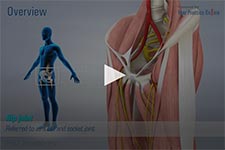
Hip Anatomy
The hip joint is the largest weight-bearing joint in the human body. It is also referred to as a ball and socket joint and is surrounded by muscles, ligaments, and tendons.
For more information about Hip Anatomy, click on below tabs.
Conditions
Hip Injuries and Tears
Snapping Hip
The hip is an important joint that helps us walk, run and jump.
For more information about Snapping Hip, click on below tabs.
Hip Pain
Hip pain, one of the common symptoms patients complain of, may not always be felt precisely over the hip joint.
For more information about Hip Pain, click on below tabs.
Muscle Strains
A tear in the muscle fibers caused by either a fall or direct blow to the muscle, overstretching and overuse injury is called a strain.
For more information about Muscle Strains, click on below tabs.
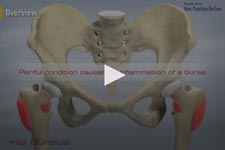
Hip Bursitis
Hip bursitis is a painful condition caused by inflammation of a bursa in the hip.
For more information about Hip Bursitis, click on below tabs.
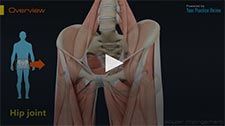
Femoroacetabular Impingement
Femoroacetabular impingement (FAI) is a condition where there is too much friction in the hip joint from bony irregularities causing pain and decreased range of hip motion.
For more information about Femoroacetabular Impingement, click on below tabs.
Avascular Necrosis
Avascular necrosis, also called osteonecrosis is a condition in which bone death occurs because of inadequate blood supply to it.
For more information about Avascular Necrosis, click on below tabs.
Hip Fracture
The hip joint is a “ball and socket” joint. The “ball” is the head of the femur, or thigh bone, and the “socket” is the cup shaped acetabulum.
For more information about Hip Fracture, click on below tabs.
Hip Dislocation
The hip joint is a ball and socket joint. The “ball” is the head of the femur, or thigh bone, and the “socket” is the cup shaped acetabulum.
For more information about Hip Dislocation, click on below tabs.
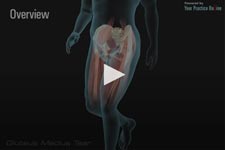
Gluteus Medius Tear
A gluteus medius tear is a condition characterized by severe strain on the gluteus medius muscle that results in partial or complete rupture of the muscle.
For more information about Gluteus Medius Tear, click on below tabs.
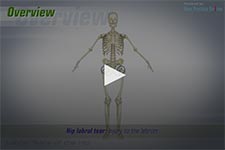
Hip Labral Tear
A hip labral tear is an injury to the labrum, the cartilage that surrounds the outside rim of your hip joint socket.
For more information about Hip Labral Tear, click on below tabs.
Chondral Lesions or Injuries
The hip joint is one of the largest weight-bearing joints in the body, formed by the thigh bone or femur and the acetabulum of the pelvis.
For more information about Chondral Lesions or Injuries, click on below tabs.
Hip Instability
The hip plays an important role in supporting the upper body weight while standing, walking and running, and hip stability is crucial for these functions.
For more information about Hip Instability, click on below tabs.
Loose Bodies
Loose bodies are small loose fragments of cartilage or a bone that float around the joint.
For more information about Loose Bodies, click on below tabs.
Hip Groin Disorders
Hip and groin disorders are more common in athletes, caused by rapid acceleration and deceleration motion.
For more information about Hip Groin Disorders, click on below tabs.
Hip Distraction
The hip joint is one of the most important and flexible joints in the human body which allows us to walk, run, bend and perform physical activities.
For more information about Hip Distraction, click on below tabs.
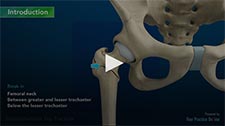
Subtrochanteric Hip Fracture
A hip fracture is a break that occurs near the hip in the upper part of the femur or thigh bone.
For more information about Subtrochanteric Hip Fracture, click on below tabs.
Hip Abductor Tears
Hip abductors are a major group of muscles found in the buttocks.
For more information about Hip Abductor Tears, click on below tabs.
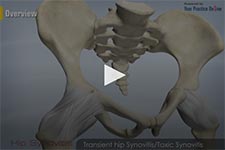
Hip Synovitis
Hip synovitis, also called transient hip synovitis or toxic synovitis is a condition in which there is inflammation of the synovial tissues surrounding the hip joint causing hip pain.
For more information about Hip Synovitis, click on below tabs.
Irritable Hip
Irritable hip, also known as acute transient synovitis, is a common disorder of childhood characterized by onset of hip pain and limping.
For more information about Irritable Hip, click on below tabs.
Hip Tendonitis
Tendons are strong connective tissue structures that connect muscle to bone.
For more information about Hip Tendonitis, click on below tabs.
Hip Pointers
The hip joint consists of 2 bones, the hip bone and the leg bone.
For more information about Hip Pointers, click on below tabs.
Developmental Dysplasia
Developmental dysplasia of the hip (DDH) or Hip dysplasia is a condition which is seen in infants and young children because of developmental problems in the hip joint.
For more information about Developmental Dysplasia, click on below tabs.
Legg-Calve-Perthes-Disease
Legg-Calve-Perthes Disease (LCPD) or Perthes disease is a disorder of the hip that affects children, usually between the ages of 4 and 10.
For more information about Legg-Calve-Perthes-Disease, click on below tabs.

Slipped Capital Femoral Epiphysis
Slipped capital femoral epiphysis (SCFE) is an unusual disorder of the hip where the ball at the upper end of the thigh bone (femur) slips in a backward direction.
For more information about Slipped Capital Femoral Epiphysis, click on below tabs.
Hip Arthritis
Osteoarthritis of the Hip
Osteoarthritis, also called degenerative joint disease is the most common form of arthritis.
For more information about Osteoarthritis of the Hip, click on below tabs.
Inflammatory Arthritis of the Hip
Inflammation of the joints is referred to as arthritis.
For more information about Inflammatory Arthritis of the Hip, click on below tabs.
Transient Osteoporosis of the Hip
Transient osteoporosis of the hip is a rare condition that causes bone loss temporarily in the upper part of the thighbone (femur).
For more information about Transient Osteoporosis of the Hip, click on below tabs.
Procedures
Non-Surgical Treatments
Hip Injections
Hip joint injections involve injecting medicine directly into the hip joint to diagnose the source of pain or treat pain due to conditions such as arthritis, injury or mechanical stress of the hip joint.
For more information about Hip Injections, click on below tabs.
Physiotherapy
Physiotherapy or physical therapy is an exercise program that helps you to improve movement, relieve pain, encourage blood...
For more information about Physiotherapy, click on below tabs.
Platelet Rich Plasma Therapy
Our blood consists of a liquid component known as plasma.
For more information about Platelet Rich Plasma Therapy, click on below tabs.
Shock-wave therapy
Shock wave therapy is application of the sound waves to treat musculoskeletal conditions and sports-related injuries.
For more information about Shock-wave therapy, click on below tabs.
Surgical Treatment
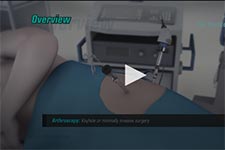
Hip Arthroscopy
Arthroscopy, also referred to as keyhole or minimally invasive surgery, is a procedure...
For more information about Hip Arthroscopy, click on below tabs.
Hip Replacements
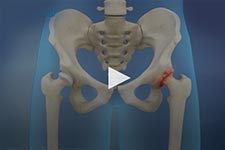
Total Hip Replacement
Total hip replacement is a surgical procedure in which the damaged cartilage and bone is removed from the hip joint and replaced with artificial components.
For more information about Total Hip Replacement, click on below tabs.
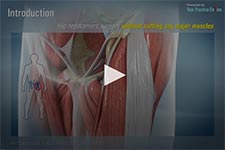
Anterior Hip Replacement
Total joint replacement surgery is one of the most advanced successful procedures in patients dealing with severe hip and knee pain.
For more information about Anterior Hip Replacement, click on below tabs.
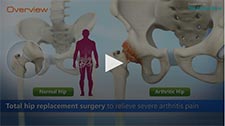
Revision Hip Replacement
Revision hip replacement is a complex surgical procedure in which all or part of a previously implanted hip-joint is replaced with a new artificial hip-joint.
For more information about Revision Hip Replacement, click on below tabs.
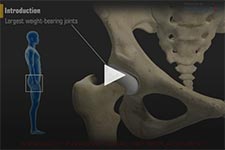
Minimally Invasive Total Hip Replacement
The hip joint is one of the body's largest weight-bearing joints and is the point where the thigh bone (femur) and the pelvis (acetabulum) join.
For more information about Minimally Invasive Total Hip Replacement, click on below tabs.
Outpatient Hip Replacement
Hip replacement surgery is the most common orthopedic surgery performed.
For more information about Outpatient Hip Replacement, click on below tabs.
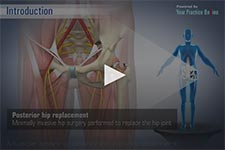
Posterior Hip Replacement
Posterior hip replacement is a minimally invasive hip surgery performed to replace the hip joint.
For more information about Posterior Hip Replacement, click on below tabs.
Others
Hip Preservation Surgery
The hip is a ball and socket joint comprising of the femur (thigh bone) and the pelvic bone.
For more information about Hip Preservation Surgery, click on below tabs.
Hip Implants
Hip implants are artificial devices that form the essential parts of the hip joint during a hip replacement surgery.
For more information about Hip Implants, click on below tabs.
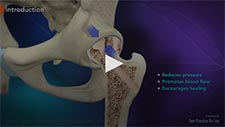
Core Decompression for Avascular Necrosis of the Hip
The hip joint is a ball and socket joint, where the head of the thigh bone (femur) articulates with the cavity (acetabulum) of the pelvic bone.
For more information about Core Decompression for Avascular Necrosis of the Hip, click on below tabs.
Hip Endoscopy
The hip joint is one of the body's largest weight-bearing joints and is the point where the thigh bone (femur) and the pelvis (acetabulum) unite.
For more information about Hip Endoscopy, click on below tabs.
Hip FAO Surgery
Femoroacetabular impingement (FAI) is a condition where the hip bones are abnormally shaped...
For more information about Hip FAO Surgery, click on below tabs.
Hip Hemiarthroplasty
The hip joint is one of the body's largest weight-bearing joints and is the point where the thigh bone (femur) and the pelvis (acetabulum) unite.
For more information about Hip Hemiarthroplasty, click on below tabs.
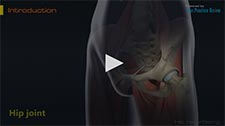
Hip Resurfacing
The hip joint is also known as a ball and socket joint, where the ball (femoral head) of the thigh bone fits into the socket (acetabulum) of the pelvis bone.
For more information about Hip Resurfacing, click on below tabs.
Birmingham Hip Resurfacing
The Birmingham Hip Resurfacing (BHR) is a metal-on-metal prosthesis used in hip resurfacing procedure.
For more information about Birmingham Hip Resurfacing, click on below tabs.
Health and Safety
Pre-op and Post-Op Hip Guidelines
Planning for your hip surgery prepares you for the operation and helps to ensure a smooth surgery and easier recovery.
For more information about Pre-op and Post-Op Hip Guidelines, click on below tabs.
Caregivers Guide for the Hip
When your friend or loved one has undergone a hip replacement surgery, as a caregiver, you will play an important role in his/her recovery.
For more information about Caregivers Guide for the Hip, click on below tabs.
Hip Fracture Prevention
Hip fractures refer to any kind of breakage or damage in the thigh bone (femur).
For more information about Hip Fracture Prevention, click on below tabs.
After Hip Replacement
Hip replacement is a surgery performed to replace parts of a diseased hip joint with an artificial prosthesis.
For more information about After Hip Replacement, click on below tabs.











